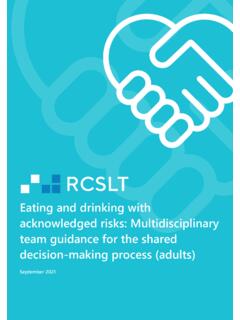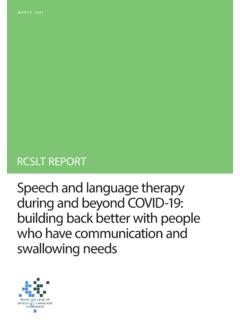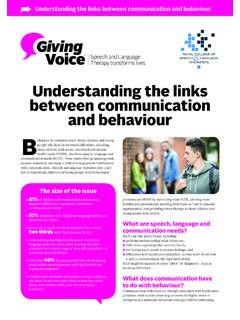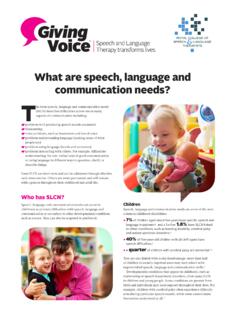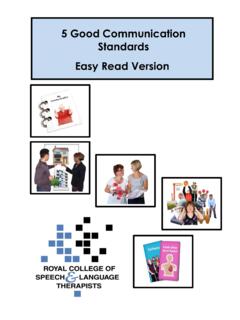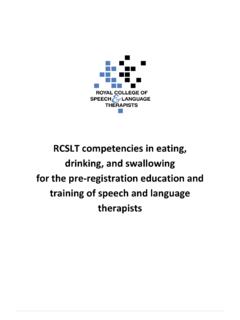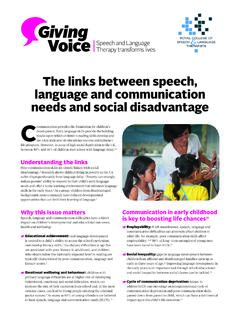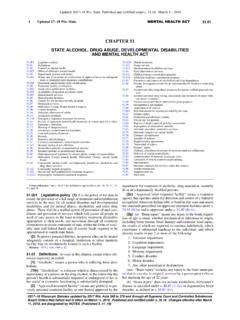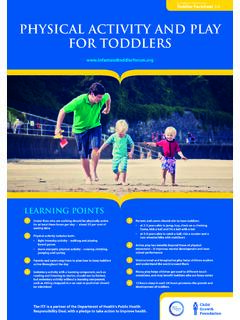Transcription of What is speech and language therapy?
1 What do speech and language therapists do? speech and language therapists (SLTs) provide life-improving treatment, support and care for children and adults who have difficulties with communication, eating, drinking or swallowing. SLTs assess and treat speech , language and communication problems in people of all ages to help them communicate better. They also assess, treat and develop personalised plans to support people who have eating and swallowing problems. Using specialist skills, SLTs work directly with clients and their carers and provide them with tailored support. They also work closely with teachers and other health professionals, such as doctors, nurses, other allied health professionals and psychologists to develop individual treatment programmes.
2 Who benefits from speech and language therapy? speech and language therapy benefits people of all ages, for example: Infants: SLTs support premature babies and infants with conditions such as cerebral palsy , cleft palate and Down syndrome from very early in life who have difficulties with drinking, swallowing and early play and communication skills. Children: SLTs support children with primary speech , language and communication difficulties, such as stammering, as well as speech , language and communication difficulties that are secondary to other conditions such as learning difficulties and hearing problems.
3 Adults with learning difficulties: SLTs support adults who have developmental conditions such as learning disabilities, autism and Down syndrome. Adults: SLTs support adults with communication and/or swallowing difficulties as a result of medical conditions, such as stroke, head and neck cancer, Parkinson s disease and is speech and language therapy? Did you know? Nearly 20% of the population may experience communication difficulties at some point in their lives. i 7% of children aged about five years have specific speech and language impairment ii and a further have speech , language and communiction needs linked to other conditions such as learning disability, cerebral palsy , autism spectrum disorders.
4 Iii speech , language and communication needs are the most common type of special educational need in 4-11 year old children. iv In some socially deprived areas upwards of half of children may start school with impoverished speech , language and communication skills. v Around a third of people will have some level of communication difficulties (called aphasia) following a stroke. vi More than 60% of young offenders can have difficulties with speech , language or communication. viiTMWhere do speech and language therapists work? speech and language therapists work together with children, adults, families, carers and the wider workforce, to carry out assessments and plan personalised therapy programmes which meet each individual s communication and swallowing needs.
5 They work in wide variety of contexts and environments including: community health centres hospital wards and intensive care units outpatient departments children s centres, mainstream and special schools assessment units, day centres and nursing homes clients homes courtrooms, prisons and young offenders institutionsThere are approximately 12,500 practising SLTs in the UK. The National Health Service employs the majority of SLTs; however, increasing numbers work wholly or partly in education or for charities, while a number work independently and treat patients privately (as well as other areas).
6 I Scottish Executive Social Research (2007) Communication support needs, a review of the literature. Tomblin, J. B., et al. (1997), Prevalence of Specific language Impairment in Kindergarten Children , Journal of speech , language and Hearing Research, 40, pp. 1245-60. Enderby et al (2013) Beyond the Anecdote: Examining the need for, and provision of, AAC in the United Kingdom. Communication Mattersiv Royal College of speech and language Therapists (2012) Better Communication: Shaping speech , language and communication services for children and young people v Locke, A., Ginsborg, J. and Peers, I.
7 (2002) Development and disadvantage: implications for the early years and beyond, International Journal of language and Communication Disorders, 37(1), pp. Stroke Association (2012). speech and language Therapy after Stroke. Stroke Association: Londonvii Bryan K, Freer J, Furlong C. language and communication difficulties in juvenile offenders. International Journal of language and Communication Disorders 2007; 42, AND RESOURCESHow speech and language therapy can helpMuriel s story: Muriel experienced word finding difficulties and problems with her memory as a result of Alzheimer s disease. Her condition made daily activities difficult and affected her ability to communicate with others.
8 A speech and language therapist helped Muriel and her family to understand Muriel s condition and design strategies in response to it. Muriel feels that therapy has helped her develop her language skills and made her feel more like herself again .Alan s story: following a mild stroke, Alan was unable to swallow food or liquids and had to consume food, fluids and medication through a tube. To support his recovery a speech and language therapist worked with Alan on a variety of daily exercises to regain his ability to swallow. Alan began to make swift progress and is now back on solid food, he hopes to have his feeding tube removed soon.
9 Cayden s story: at age three, Cayden was identified as having a speech sound disorder. He was struggling to be understood by anyone other than his mum and dad and was mocked by other children because of his speech difficulty. Following three years of intensive speech therapy, according to his mum, Cayden s life has transformed. His communication skills and education performance have improved; he enjoys public speaking and has made new friends.
